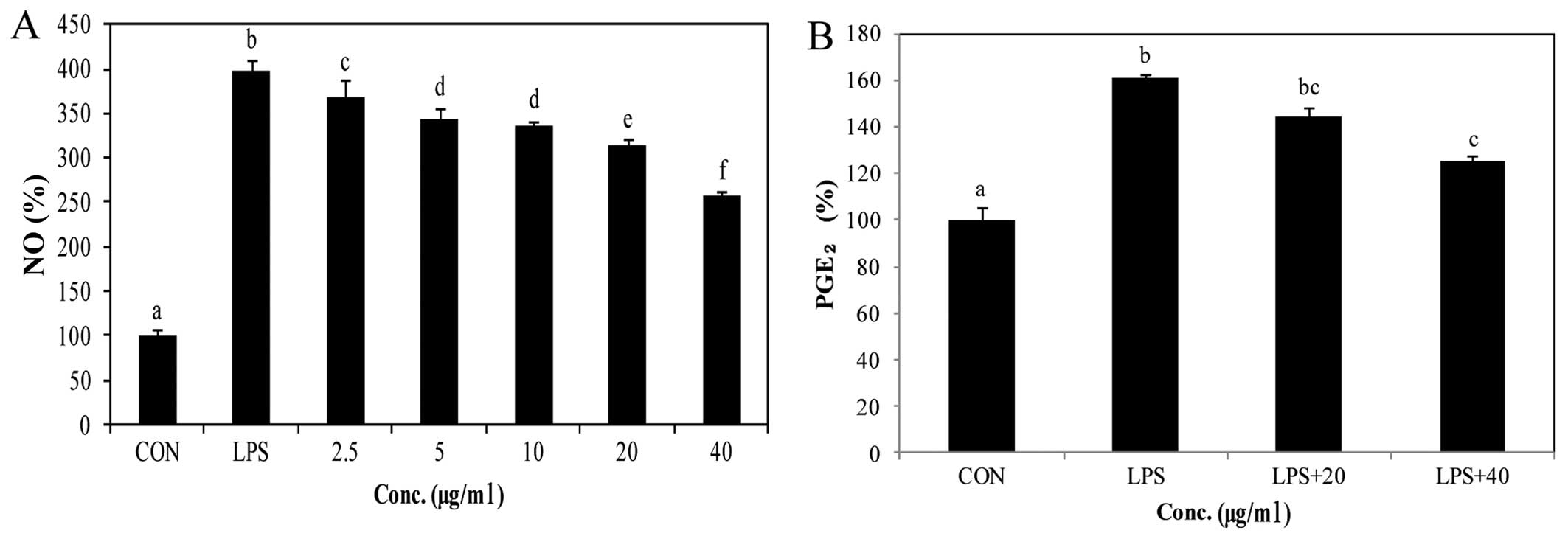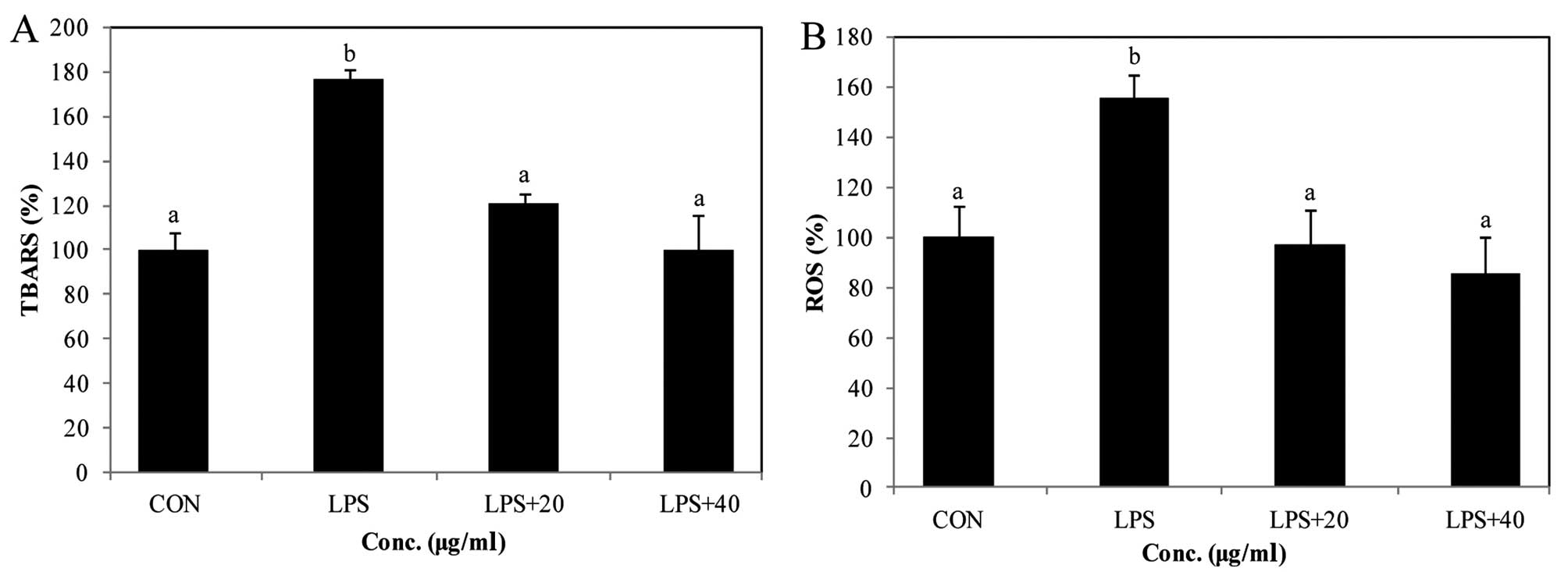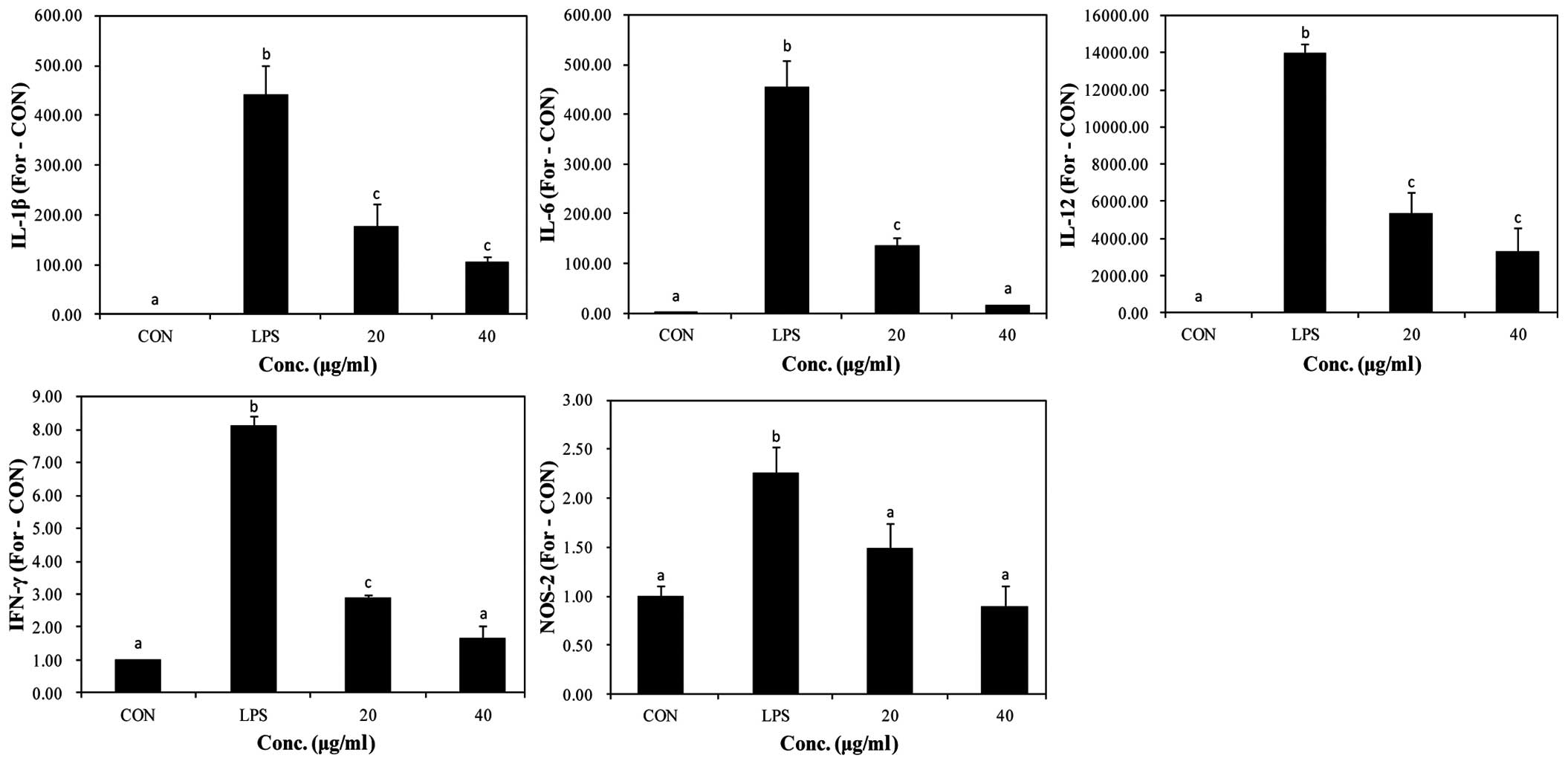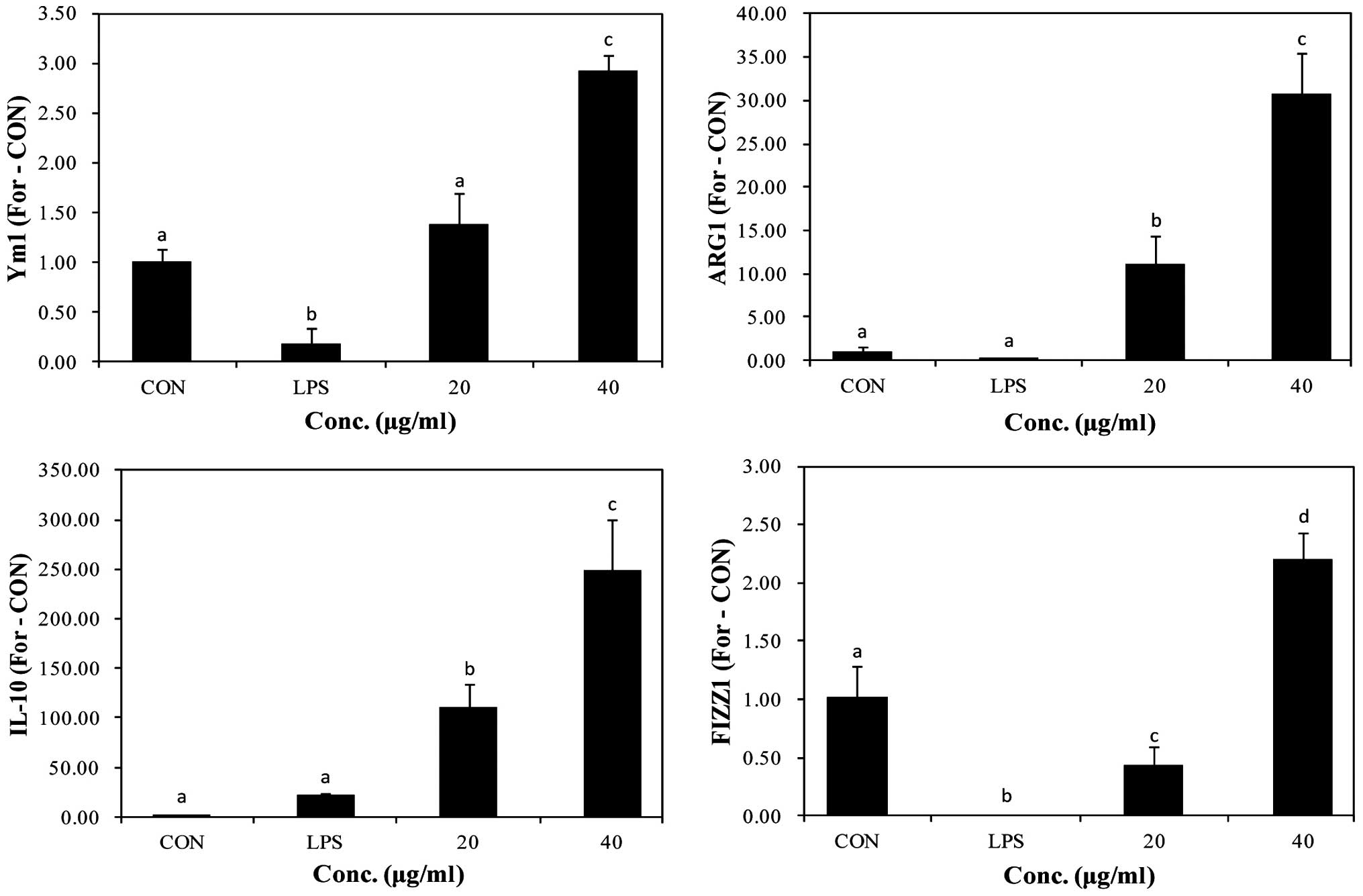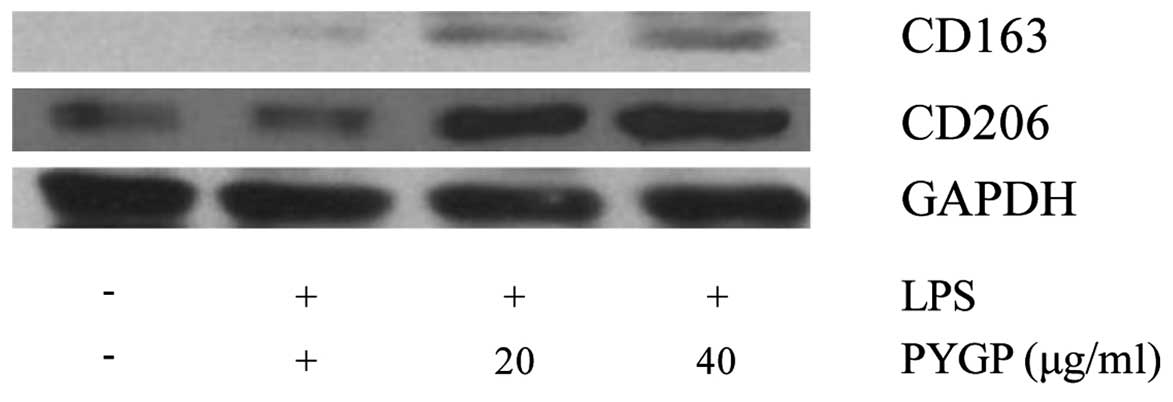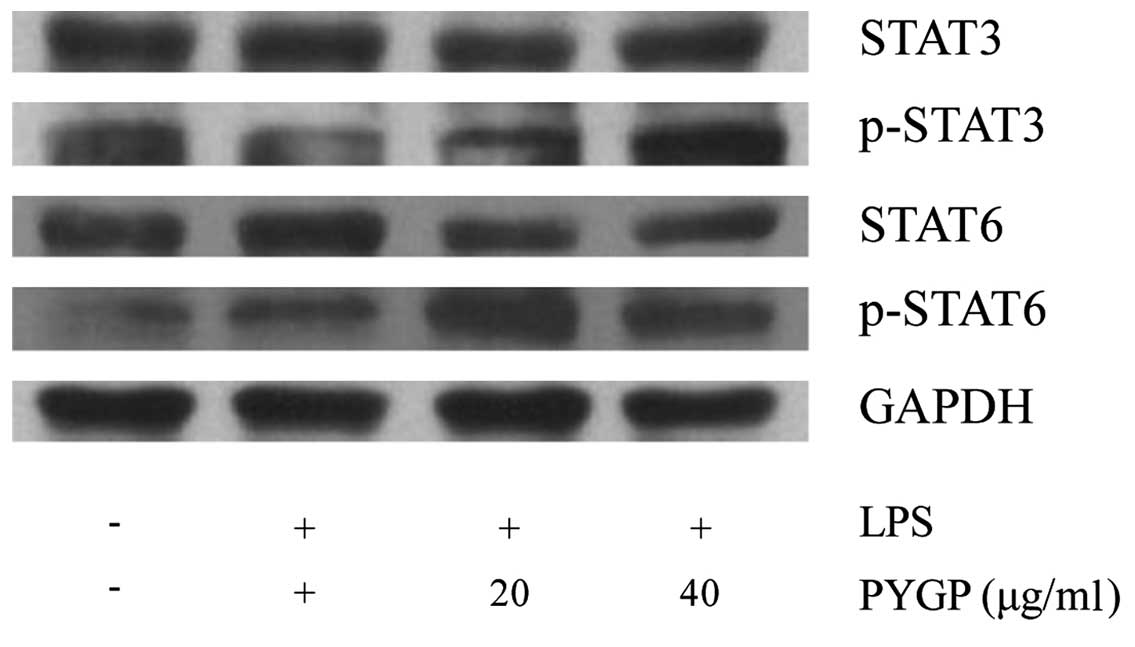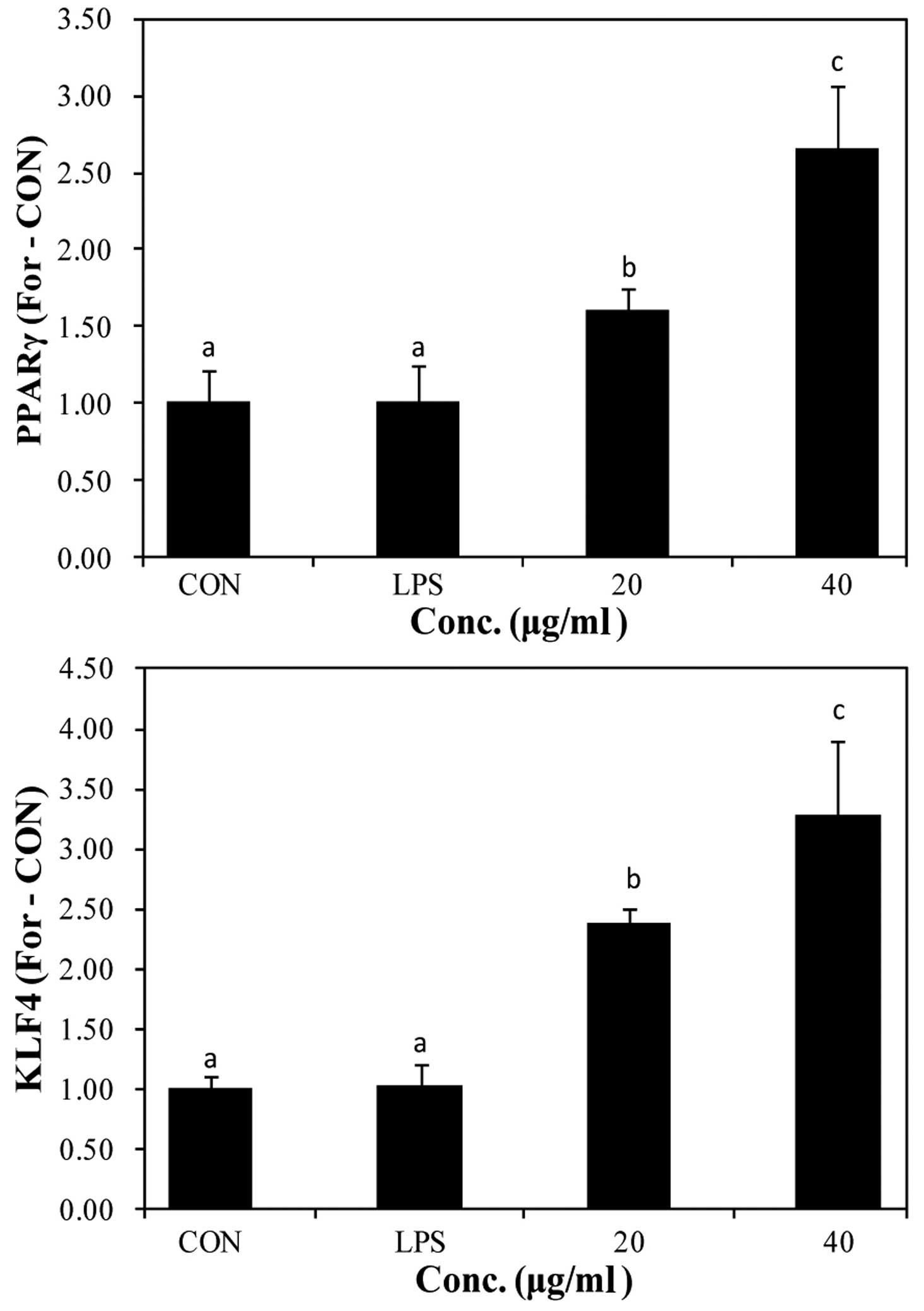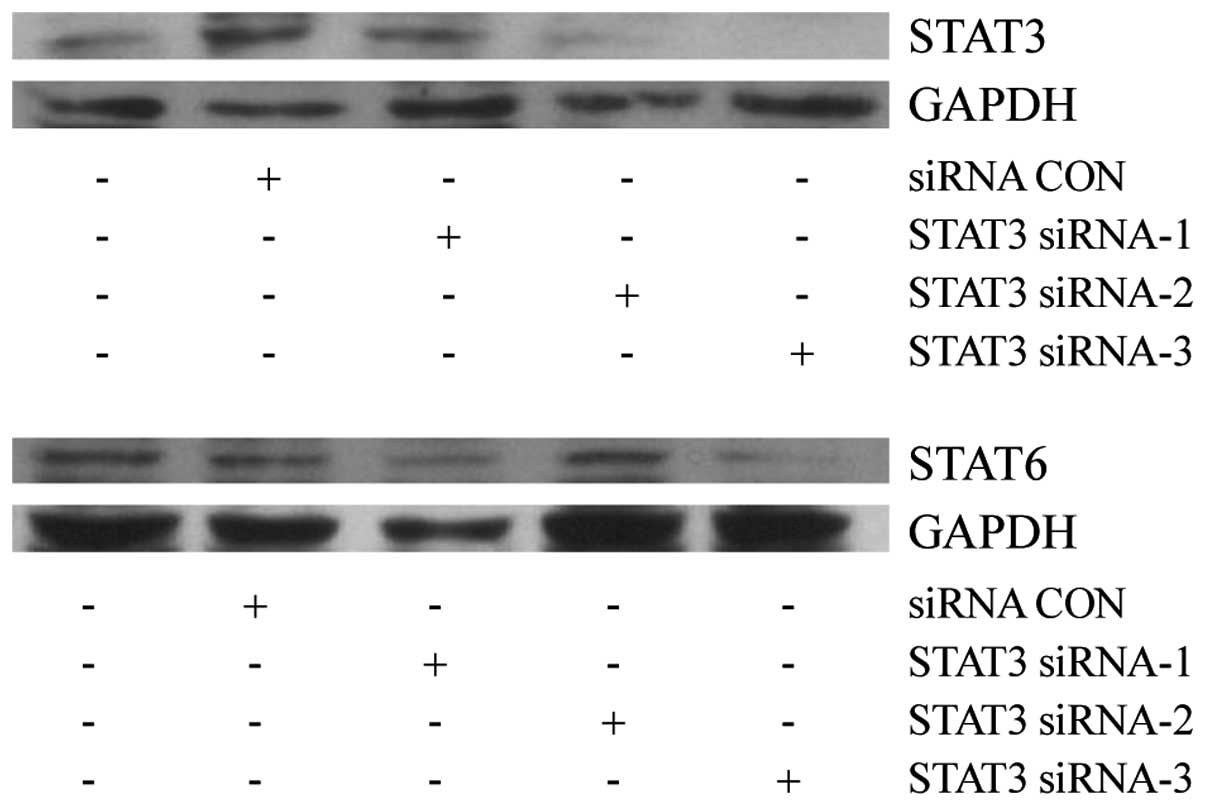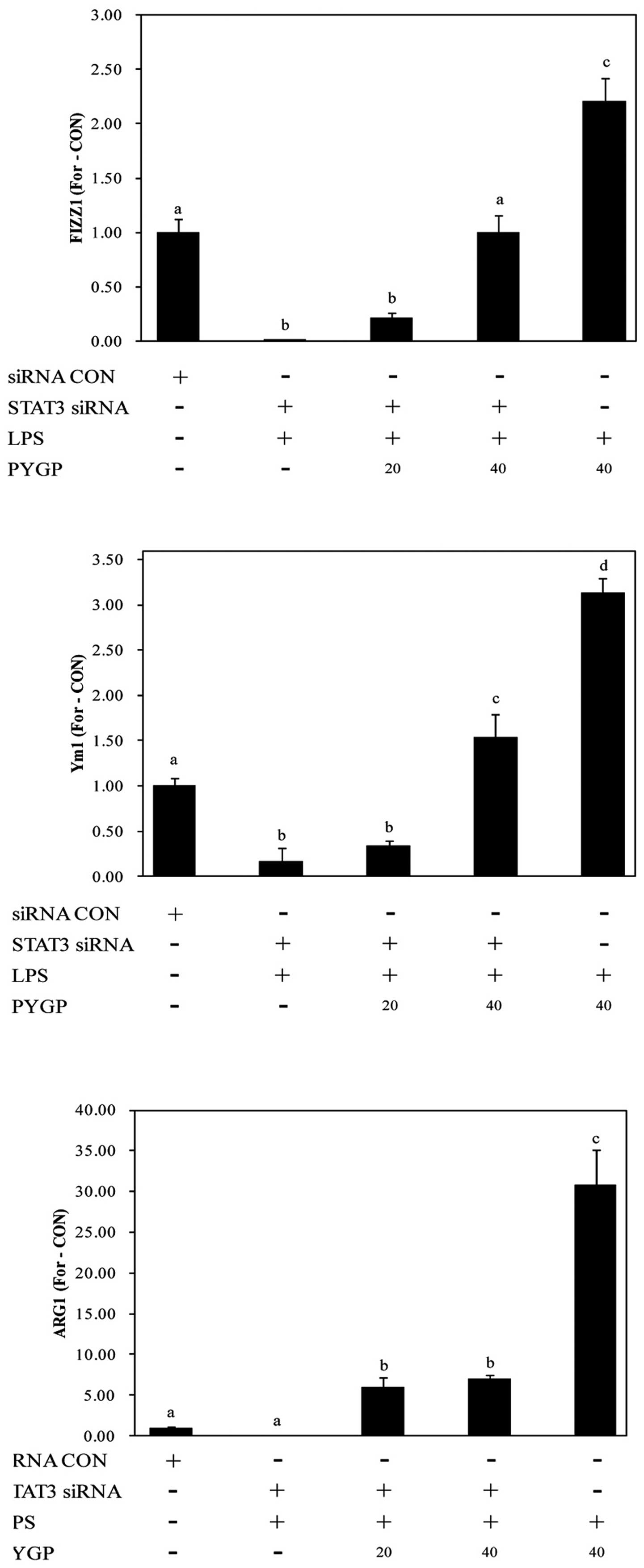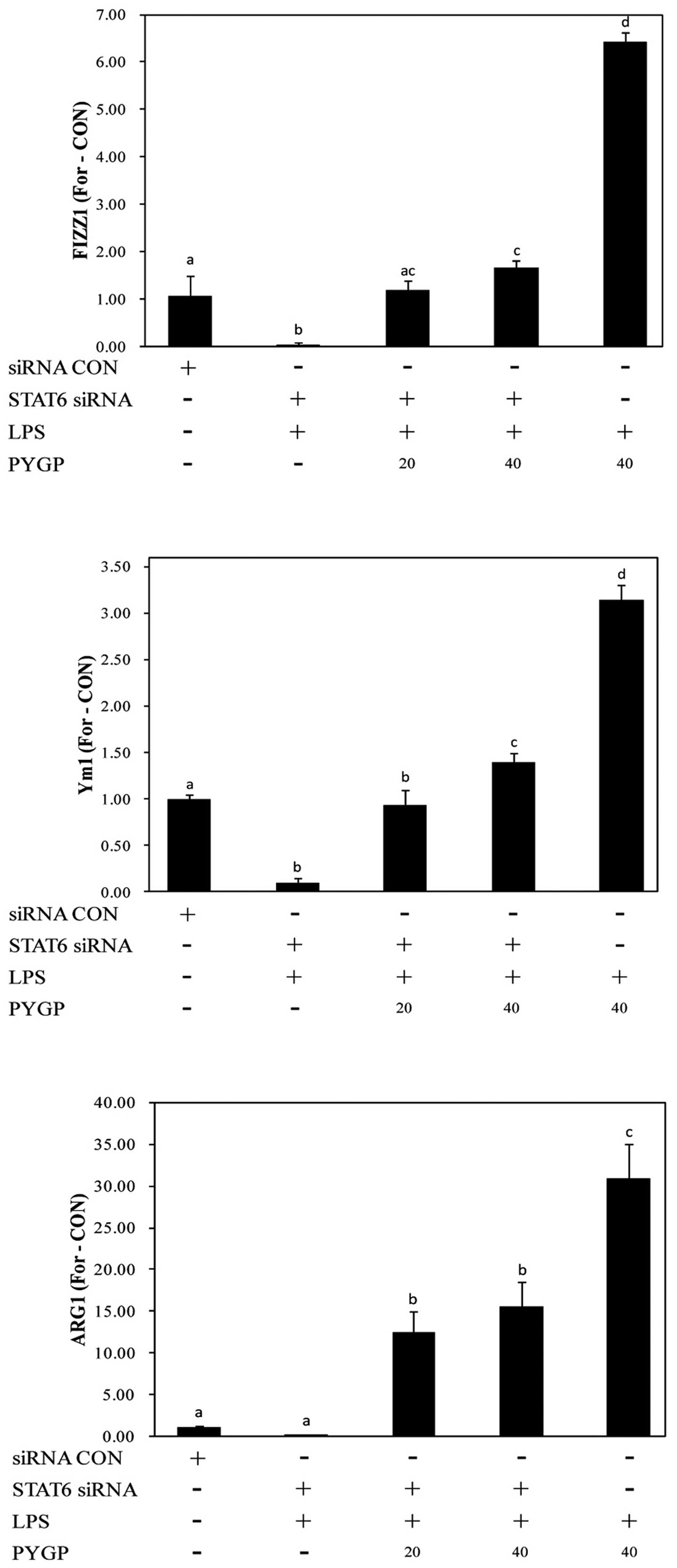Pyropia yezoensis glycoprotein promotes the M1 to M2 macrophage phenotypic switch via the STAT3 and STAT6 transcription factors
- Authors:
- Published online on: June 24, 2016 https://doi.org/10.3892/ijmm.2016.2656
- Pages: 666-674
Abstract
Introduction
Macrophages are well-known not only as major regulators of innate and adaptive immunity, but also important mediators of systemic metabolism, hematopoiesis, vasculogenesis, apoptosis, malignancy and reproduction (1–4). There are two differentiation patterns, M1 and M2. M1 macrophages (classically activated macrophages) act as regulators of the host defense system. They protect from infection due to bacteria, protozoa and viruses (5). M2 macrophages (alternatively activated macrophages) have been reported to have anti-inflammatory activity and are important in wound healing (6). This plasticity can change according to the macrophage environment.
M1 activation is induced by interferon-γ (IFN-γ) and lipopolysaccharide (LPS). The M1 phenotype upregulates pro-inflammatory cytokines and chemokines [e.g., tumor necrosis factor-α (TNF-α), interleukin (IL)-12, IL-6, IL-1β and CCL2] and promotes the production of reactive oxygen and nitrogen species (ROS and RNS) (8,9). LPS is well known as a stimulant for macrophages, and it is recognized for the activation of the Toll-like receptor 4 (TLR4)-related signaling pathway. TLR4 leads to the activation of the MyD88 and MaL/Tirap-dependent pathways, leading to the rapid switch to the M1 phenotype (10). The secretion of cytokines and chemokines in macrophages with the M1 phenotype is related to various transcription factors, such as nuclear factor-κB (NF-κB), activator protein 1 (AP-1), interferon-regulatory factors (IRF)s and signal transducer and activator of transcription (STAT)1 (11). M1 macrophages have been reported to play an important role in chronic inflammatory diseases. Consequently, the abnormal or long-term activation of macrophages must be controlled to prevent damage to the host.
M2 activation is related to Th2-produced IL-4 and IL-13 (12). M2 macrophages are associated with the upregulation of galactose receptor, mannose receptor-1, chitinase-like 3 (Chil3; also known as Ym1), resistin like beta (RETNLB; also known as FIZZ1) and arginase 1 (ARG1) (13). Different metabolic processes are induced between M1 and M2. In particular, L-arginine metabolizes to produce nitric oxide (NO) in M1 macrophages, but in M2 macrophages L-arginine metabolizes to produce polyamines (1).
Pyropia yezoensis (P. yezoensis; Rhodophyta, Bangiaceae) is widely used as a food in Korea, China and Japan. P. yezoensis had been used as a medicine for the treatment of emesis, diarrhea and hemorrhoids in oriental medicine (14). P. yezoensis protein has been reported to have angiotensin I converting enzyme inhibitory activities (15), and to exert anti-inflammatory (16) and liver protective effects against acetaminophen (17).
In this study, we examined the effects of P. yezoensis glycoprotein (PYGP) on M1 to M2 macrophage polarization in lipopolysaccharide (LPS)-stimulated macrophages. In particulary, we focused on the similarities of the biological functions of anti-inflammation and wound healing between P. yezoensis and M2 polarization.
Materials and methods
Cell culture
RAW 264.7 cells were obtained from the American Type Culture Collection (ATCC, Manassas, VA, USA). The cells were grown in Dulbecco's modified Eagle's medium (DMEM; Gibco-BRL, Gaitherburg, MD, USA) containing 10% fetal bovine serum (FBS) and 1% penicillin/streptomycin (both from Gibco-BRL). The cells were maintained at 37°C in 5% CO2 humidified atmosphere, and were subcultured at approximately 70–80% confluence in 100 mm diameter culture dish, and the medium was replaced every 2 days.
Preparation of PYGP
P. yezoensis was obtained from the Republic of Korea in 2014 (Suhyup, Busan, South Korea). P. yezoensis powder (40 g) was diluted with 1 liter distilled water and stirred for 4 h at room temperature. The solution was centrifuged at 3000 × g, 4°C for 20 min and vacuum filtered, and triple volumes of ethanol (supernatant 1:ethanol 3) were added. After 24 h, the solution was filtered and concentrated by rotary evaporation at 40°C. The concentrated solution was divided into 1.5 ml tubes, freeze-dried and stored at −70°C until further use.
Cell treatment
The cells were treated with PYGP (2.5, 5, 10, 20 and 40 µg/ml) for 24 h and then stimulated with 1 µg/ml LPS with PYGP (2.5, 5, 10, 20 and 40 µg/ml) for 24 h.
Determination of nitrite concentration
The nitrite concentration in the cultured medium was determined using Griess reagent (Enzo Life Sciences, Farmingdale, NY, USA). Fifty microliters of supernatant from the 96-well plates were mixed with the same volume of Griess reagent. After 30 min, the absorbance was measured at 540 nm using a Benchmark Plus 10730 microplate reader (Benchmark; Bio-Rad Laboratories, Inc., Hercules, CA, USA). Phe percentage of nitrite concentration was calculated using the following formula: NO (%) = AT/AC ×100, where AC is the absorbance of the control and AT is the absorbance of the test group.
Determination of prostaglandin E2 (PGE2) levels
The levels of PGE2 in the RAW 264.7 macrophages were measured using the PGE2 express EIA kit according to the manufacturer's instructions (Cayman, Ann Arbor, MI, USA). The absorbance was measured using a microplate reader (Benchmark plus 10730; Bio-Rad Laboratories, Inc.). The percentage of PGE2 was calculated using the following formula: PGE2 (%) = AT/AC ×100, where AC is the absorbance of the control and AT is the absorbance of the test group.
Determination of ROS generation
The levels of ROS were determined using 2′,7′-dichlorofluorescenin diacetate (DCF-DA; Sigma-Aldrich, St. Louis, MO, USA). The RAW 264.7 cells were incubated with DCF-DA for 30 min in the dark. The cells were then washed twice with ice-cold phosphate-buffered saline (PBS). The level of ROS was analyzed at an excitation wavelength of 480 nm and an emission wavelength of 535 nm using a fluorescence microplate reader (FilterMAX F5; Molecular Devices, LLC, Sunnyvale, CA, USA). The percentage of ROS was calculated as follows: ROS (%) = AT/AC ×100, where AC is the absorbance of the control and AT is the absorbance of the test group.
Determination of thiobarbituric acid reactive substances (TBARS)
The levels of TBARS in the RAW 264.7 cells were measured using the TBARS assay kit according to the manufacturer's instructions (Cell Biolabs, San Diego, CA, USA). The absorbance was measured using a microplate reader (Benchmark plus 10730; Bio-Rad Laboratories, Inc.). The percentage of TBARS was calculated as follows: TBARS (%) = AT/AC ×100, where AC is the absorbance of the control and AT is the absorbance of the test group.
Western blot analysis
The RAW 264.7 cells were washed with ice-cold PBS (0.15 M sodium phosphate, 0.15 M sodium chloride, pH 7.4; Gibco-BRL), followed by lysis buffer [150 mM sodium chloride, 50 mM Tris-HCl (pH 7.5), 0.5% sodium deoxycholate, 0.1% sodium dodecyl sulfate, 1% Triton X-100, and 2 mM ethylenediaminetetra-acetic acid; Intron Biotechnology Inc., Seongnam, Korea] with inhibitors (1 mM Na3VO4, 1 µg/ml aprotinin, 1 µg/ml leupeptin, 1 µg/ml pepstatin A and 1 mM PMSF; Sigma-Aldrich). Protein levels were determined using the bichinchominic acid assay kit (Pierce Biotechnology, Rockford, IL, USA). Equal protein amounts (20 µg) of each sample were separated by 10–15% sodium dodecyl sulfate (SDS)-polyacrylamide gel and transferred onto a polyvinylidene fluoride membrane (Millipore, Billerica, MA, USA). The transferred membrane was blocked with 1% bovine serum albumin (BSA) in TBS-T [10 mM Tris-HCl (pH 7.5), 150 mM NaCl, and 0.1% Tween-20; USB Corporation, Cleveland, OH, USA]. Subsequently, the membrane was incubated for 4 h at room temperature with the following primary immunoglobulin G antibodies, diluted to 1:1,000 in BSA/TBS-T: rabbit anti-mouse STAT3 polyclonal antibody (sc-482), goat anti-mouse p-STAT3 polyclonal antibody (sc-7993), rabbit anti-mouse STAT6 polyclonal antibody (sc-621), rabbit anti-mouse p-STAT6 polyclonal antibody (sc-11762), rabbit anti-mouse CD163 polyclonal antibody (sc-33560), rabbit anti-mouse CD206 polyclonal antibody (sc-48758), rabbit anti-mouse glyceraldehyde 3-phosphate dehydrogenase (GAPDH) polyclonal antibody (sc-25778) (all from Santa Cruz Biotechnology Inc., Dallas, TX, USA). The secondary antibodies were peroxidase-conjugated anti-goat (81-1620), anti-mouse (62-6520), and anti-rabbit (65-6120) antibodies (1:10,000; Bethyl Laboratories, Montgomery, TX, USA). Antibody binding was visualized using the Super Signal West Pico Stable Peroxide Solution and the Super Signal West Pico Luminol/Enhancer solution (Thermo Fisher Scientific Inc., Rockford, IL, USA). The signal was monitored using Kodak X-ray film and a developer and fixer twin pack (both from Kodak, Rochester, NY, USA).
Reverse transcription-quantitative polymerase chain reaction (RT-qPCR)
Total RNA was extracted from the cells using TRIzol reagent (Invitrogen, Carlsbad, CA, USA). cDNA was sythesized using RevoScript™ RT preMix (Intron Biotechnology Inc.). The synthesized cDNA and primer were added to 2X TOPsimple™ DyeMIX-nTaq (Enzynomics Inc., Deajeon, Korea). Amplifications were performed using TOPreal™ qPCR 2X PreMIX SYBR-Green (Enzynomics Inc.) in a Eco™ Real-Time PCR system (Illumina Inc., San Diego, CA, USA). Gene expression levels were normalized to GAPDH and calculated using the comparative ΔΔCT method, as previously described (18). The oligonucleotide primers used for PCR were as follows: IL-12 forward, 5′-CGT GCT CAT GGC TGG TGC AAA-3′ and reverse, 5′-CTT CAT CTG CAA GTT CTT GGG-3′; IFN-γ, forward, 5′-ACA CTC ATT GAA AGC CTA GAA AGT CTG-3′ and reverse, 5′-ATT CTT CTT ATT GGC ACA CTC TCT ACC-3′; IL-6 forward, 5′-GTT CTC TGG GAA ATC GTG GA-3′ and reverse, 5′-TGT ACT CCA GGT AGC TAT GG-3′; nitric oxide synthase-2 (NOS-2) forward, 5′-CTG CAT GGA ACA GTA TAA GGC AAA C-3′ and reverse, 5′-CAG ACA GTT TCT GGT CGA TGT CAT GA-3′; IL-1β forward, 5′-GTG TGG ATC CCA AGC AAT ACC CA-3′ and reverse, 5′-CCA GCC CAT ACT TTA GGA AGA CAC AGA-3′; Ym1 forward, 5′-GGA TGG CTA CAC TGG AGA AA-3′ and reverse, 5′-AGA AGG GTC ACT CAG GAT AA-3′; FIZZ1 forward, 5′-CCC TCC ACT GTA ACG AAG-3′ and reverse, 5′-GTG GTC CAG TCA ACG AGT AA-3′; ARG1 forward, 5′-CTC CAA GCC AAA GTC CTT AGA G-3′ and reverse, 5′-AGG AGC TGT CAT TAG GGA CAT C-3′; IL-10 forward, 5′-CTG CTC CAC TGC CTT GCT CTT ATT-3′ and reverse, 5′-GTG AAG ACT TTC TTT CAA ACA AAG-3′; Krüppel-like factor 4 (KLF4) forward, 5′-GCA CAC CTG CGA ACT CAC AC-3′ and reverse, 5′-CCG TCC CAG TCA CAG TGG TAA-3′; peroxisome proliferator-activated receptor γ (PPARγ) forward, 5′-ACC ACT CGC ATT CCT TTG AC3′ and reverse, 5′-AAC CAT TGG GTC AGC TCT TG-3′; GAPDH forward, 5′-ACT CCA CTC ACG GCA AAT TCA-3′ and reverse, 5′-CGC TCC TGG AAG ATG GTG-3′.
Small interfering RNA (siRNA) transfection
STAT3 (5′-CCC GCC AAC AAA UUA AGA ATT-3′ and 3′-UUC UUA AUU UGU UGG CGG GTT-5′) and STAT6 (5′-CCA AGA CAA CAA CGC CAA ATT-3′ and 3′-UUU GGC GUU GUU GUC UUG GTT-5′) and silencer negative control siRNAs were purchased from GenePharma (Shanghai, China). It should be noted that initially, we purchased 3 types of siRNAs for STAT3 and STAT6 (siRNA-1-3, respectively). From these siRNAs, STAT3 siRNA-3 and STAT6 siRNA-3 most effectively suppressed the expression of STAT3 and STAT6, respectively. Thus, these siRNAs were recorded and used in our experiments. The RAW 264.7 cells were transiently transfected with siRNA for 24 h using Lipofectamine 2000 reagent (Invitrogen), according to the manufacturer's instructions. Following transfection, the medium was replaced with fresh culture medium.
Statistical analysis
Values are presented as the means ± standard deviation and data were analyzed with SPSS ver. 10.0 software (SPSS Inc., Chicago, IL, USA) using an analysis of variance followed by a Duncan's multiple range test. P-values <0.05 were considered to indicate statistically significant differences.
Results
Effect of PYGP on LPS-induced NO release
We used Griess reagent to determine the production of NO (Fig. 1A). In the macrophages stimulated with LPS, NO production was significantly increased, and NO was released into the extracellular matrix. However, the NO concentration was high in the culture medium only in the LPS only-treated group. In the presence of PYGP, the concentration of NO in the culture medium was inhibited in a dose-dependent manner (Fig. 1A).
Effect of PYGP on LPS-induced PGE2 production
The production levels of PGE2 were measured in the LPS-stimulated RAW 264.7 cells (Fig. 1B). PGE2 secretion into the supernatant of the cell cultures was estimated by PGE2 express ELISA kit. Following stimulation with LPS (1 µg/ml), PGE2 expression in the medium was markedly increased. However, when the RAW 264.7 cells were pre-treated with PYGP, PGE2 expression was significantly decreased.
Effect of PYGP on LPS-induced TBARS and ROS generation
TBARS formation was determined in the LPS-stimulated RAW 264.7 cells through oxidative stress mechanisms (Fig. 2A). Our results revealed that the TBARS levels in the cells were significantly higher in the LPS only-treated group. In addition, pretreatment with PYGP significantly decreased the TBARS levels in the RAW 264.7 cells in comparison with the LPS only-treated group.
We also wished to determine whether PYGP attenuates ROS generation in LPS-stimulated RAW 264.7 cells using DCF-DA (Fig. 2B). The LPS-stimulated RAW 264.7 cells significantly generated ROS compared with the unstimulated controls. However, pre-treatment with PYGP markedly decreased the generation of ROS induced by LPS.
Effects of PYGP on M1 polarization markers
It is known that M1-activated RAW 264.7 macrophages produce pro-inflammatory cytokines. Thus, in our study, in order to examine the effects of PYGP on the LPS-stimulated RAW 264.7 cells, we determined the mRNA expression of pro-inflammatory cytokines (Fig. 3). The results of RT-qPCR revealed that LPS upregulated the mRNA expression of the pro-inflammatory cytokines, IL-1β, IL-6, IL-12, IFN-γ and NOS-2. Pre-treatment with PYGP significantly suppressed the mRNA expression of these pro-inflammatory cytokines. These results suggest that PYGP suppresses pro-inflammatory cytokine expression and prevents the M1 activation of LPS-stimulated RAW 264.7 macrophages.
Effects of PYGP on M2 polarization markers
M2-activated RAW 264.7 macrophages lead to metabolic alterations. Consequently, macrophages produce Ym1, ARG1, IL-10 and FIZZ1. The mRNA expression of M2 markers was not observed in the control group and LPS-stimulated. However, in the PYGP-treated cells, the mRNA expression of M2 marker genes increased (Fig. 4). These results indicate that PYGP prevents the induction of the M1 macrophage phenotype by LPS and promotes the switch to the M2 phenotype.
There is evidence to indicate that non-opsonic receptors, such as CD163 and CD206 are upregulated M2-activated macrophages (38,39). In this study, we used western blot analysis to measure the protein expression levels of CD163 and CD206 (Fig. 5). Stimulation with LPS decreased CD163 and CD206 expression in the RAW 264.7 cells. In the cells pretreated with PYGP, the expression levels of CD163 and CD206 were significantly increased compared with those of the control and the LPS only-treated groups.
Effects of PYGP on the STAT3 and STAT6 signaling pathways
STAT3 and STAT6 are well known transcription factors that induce M2 macrophage activation and inhibit inflammation. Thus, we measured the phosphorylation levels of STAT3 and STAT6 by western blot analysis (Fig. 6). Our results revealed that stimulation with LPS did not affect STAT3 and STAT6 phosphorylation. In the PYGP-pre-treated cells, the phosphorylation levels of STAT3 and STAT6 were increased in a dose-dependent manner. However, the total STAT3 and STAT6 protein expression levels were not altered following treatment with LPS or pre-treatment with PYGP.
The expression of PPARγ and KLF4 has been reported to increase by STAT6 phosphorylation. The increased expression of PPARγ and KLF4 promotes the switch to the M2 macrophage phenotype (19,20). We used RT-qPCR to determine the mRNA expression of PPARγ and KLF4 following stimulation with LPS and pre-treatment with PYGP (Fig. 7). Stimulation with LPS did not affect PPARγ and KLF4 mRNA expression compared with the control group. However, pre-treatment with PYGP increased PPARγ and KLF4 mRNA expression in a dose-dependent manner.
Analysis of M2 polarization markers following transfection with siRNA targeting STAT3 and STAT6
STAT3 and STAT6 are major transcription factors that are involved in the regulation of the immune response by macrophages. STAT3 and STAT6 are essential for macrophage differentiation into the M2 phenotype (23,43). In this study, to clarify whether STAT3 and STAT6 play a role in the PYGP-mediated M2 activation of RAW 264.7 cells, we examined the expression of M2 markers following the knockdown of STAT3 and STAT6 gene expression. We tested 3 types of STAT3 and STAT6 siRNA, and the expression of STAT3 and STAT6 was most significantly downregulated using STAT3 siRNA-3 and STAT6 siRNA-3, respectively (Fig. 8). Transfection of the RAW 264.7 cells with STAT3 siRNA and STAT6 siRNA attenuated the PYGP-induced increase in the mRNA expression of FIZZ1, Ym1 and ARG1 (Figs. 9 and 10). These results indicate that the activation of STAT3 and STAT6 plays an important role in the switch from the M1 to the M2 RAW 264.7 macrophage phenotype induced by PYGP.
Discussion
Macrophages play a key role in the early stages of the adaptive immune reponse, the innate immune response and in the regulation of inflammation. Macrophages can differentiate into different phenotypes, namely the M0 (unstimulated state), M1 (classical activation) and the M2 (alterative activation) phenotype (21). IFN, TNF, GM-CSF and TLR ligand stimulation promotes the production of pro-inflammatory cytokines, such as IL-1β, IL-6, TNF-β, IL-12, IFN-γ. Moreover, it promotes the switch to the M1 macrophage phenotype (22,23). IL-4, IL-13, IL-10, glucocorticoids and M-CSF stimulation promotes the secretion of IL-1ra, IL-10, TGF-β and the switch to the M2 macrophage phenotype (24).
LPS is a major stimulator of the M1 macrophage phenotype via TLR4 stimulation in (25). LPS-activated M1 macrophages produce NO and PGE2, and protect the host against infections. However, the abnormal and chronic production of NO and PGE2 leads to the development of various diseases (26,27). In this study, we demonstrated that stimulation with LPS significantly increased NO and PGE2 production, which were inhibited by pre-treatment of the RAW 264.7 cells with PYGP.
The classical activation of M1 macrophages increases aerobic glycolysis, glucose uptake and the conversion of pyruvate to lactate (28,29). Moreover, ROS production is increased from the mitochondria via NADPH oxidase activation (30). Lipid peroxidation-produced ROS cause cellular injury by the inactivation of membrane enzymes and receptors (31). In the present study, the levels of ROS and TBARS were increased in the LPS treatment group compared with the control group. However, pre-treatment with PYGP significantly decreased the LPS-induced production of ROS and TBARS.
M1 and M2 macrophages do not only differ in their biological functions, but also as regards metabolism. The main differentiation between M1 and M2 macrophages is L-arginine metabolism. L-arginine has three metabolic pathways, including NO production by NOS-2, ureum and L-ornithine by arginase and agmatine by arginine decarboxylase (29,32,33). These characteristics can be utilized in macrophages in the active state. Lipid metabolism also differs between M1 and M2 macrophages. This differentiation is revealed by the transcriptional profiling of the IL-13-steered human monocyte (34). The function of these genes is not yet fully understood, such as that of FIZZ. PPAR ligation has been reported to inhibit the expression of pro-inflammatory cytokines and NOS-2 (35,36). Futhermore, differences in cytokine secretion have been observed between M1 and M2 macrophages. M1 secrete pro-inflammatory cytokines, such as IL-1β, IL-6, IL-12 and type 1 IFN, whereas M2 secrete anti-inflammatory cytokines, such as IL-10 and TGF-β (37). In addition, IL-4, IL-13 and IL-10 upregulate several non-opsonic receptors, such as mannose receptor (CD206) and CD163 (38,39). These features have been used in many studies as markers to distinguish between the activity of macrophages (40–42). In the present study, LPS increased the production of pro-inflammatory cytokines, including IL-1β, IL-6, IL-12, IFN-γ and NOS-2. However, pre-treatment with PYGP inhibited these pro-inflammatory cytokines and increased the expression of M2-associated markers, such as CD163, CD206, Ym1, FIZZ1 and ARG1. These results suggest that PYGP promotes the switch from the M1 to the M2 phenotype following stimulation with LPS.
M2 activation has been shown to involve various transcription factors. STAT3 and STAT6 play a key role in M2 activation (23,43). STAT3 is the major anti-inflammatory mediator, mediate IL-10 transcription (44). The knockdown of STAT3 and STAT6 in mouse and human macrophages has been reported be prevent the switch to the M2 phenotype (7,45,46). In the present study, the silencing of STAT3 and STAT6 inhibited the promoting effects of PYGP on the mRNA expression of M2 activation markers, including FIZZ1, Ym1 and ARG1. According to our observation, STAT3 siRNA and STAT6 siRNA decreased STAT3, STAT6, FIZZ1, Ym1 and ARG1 mRNA expression in the PYGP-treated M1 macrophages, indicating that the pre-treatment of M1 activated macrophages with PYGP promotes the switch to the M2 macrophage phenotype via STAT3 and STAT6 signaling.
In conclusion, our results demonstrate that stimulation with LPS activates M1 macrophages. PYGP inhibits the production of pro-inflammatory cytokines and promotes the switch to the M2 phenotype via STAT3 and STAT6 activation. These findings may provide a molecular basis for the use of PYGP as a treatment agent for LPS-induced inflammatory diseases.
Acknowledgments
This study was supported by the Research Program through the National Research Foundation of Korea (NRF) funded by the Ministry of Education (grant no. 2012R1A6A1028677).
References
|
Tugal D, Liao X and Jain MK: Transcriptional control of macrophage polarization. Arterioscler Thromb Vasc Biol. 33:1135–1144. 2013. View Article : Google Scholar : PubMed/NCBI | |
|
Lin SL, Li B, Rao S, Yeo EJ, Hudson TE, Nowlin BT, Pei H, Chen L, Zheng JJ, Carroll TJ, et al: Macrophage Wnt7b is critical for kidney repair and regeneration. Proc Natl Acad Sci USA. 107:4194–4199. 2010. View Article : Google Scholar : PubMed/NCBI | |
|
Nikolic-Paterson DJ and Atkins RC: The role of macrophages in glomerulonephritis. Nephrol Dial Transplant. 16(Suppl 5): 3–7. 2001. View Article : Google Scholar : PubMed/NCBI | |
|
Aliprantis AO, Diez-Roux G, Mulder LC, Zychlinsky A and Lang RA: Do macrophages kill through apoptosis? Immunol Today. 17:573–576. 1996. View Article : Google Scholar : PubMed/NCBI | |
|
Murray PJ and Wynn TA: Protective and pathogenic functions of macrophage subsets. Nat Rev Immunol. 11:723–737. 2011. View Article : Google Scholar : PubMed/NCBI | |
|
Barros MHM, Hauck F, Dreyer JH, Kempkes B and Niedobitek G: Macrophage polarisation: An immunohistochemical approach for identifying M1 and M2 macrophages. PLoS One. 8:e809082013. View Article : Google Scholar : PubMed/NCBI | |
|
Gordon S and Martinez FO: Alternative activation of macrophages: Mechanism and functions. Immunity. 32:593–604. 2010. View Article : Google Scholar : PubMed/NCBI | |
|
Kohchi C, Inagawa H, Nishizawa T and Soma G: ROS and innate immunity. Anticancer Res. 29:817–821. 2009.PubMed/NCBI | |
|
Schroder K, Sweet MJ and Hume DA: Signal integration between IFNgamma and TLR signalling pathways in macrophages. Immunobiology. 211:511–524. 2006. View Article : Google Scholar : PubMed/NCBI | |
|
Martinez FO and Gordon S: The M1 and M2 paradigm of macrophage activation: Time for reassessment. F1000Prime Rep. 6:132014. View Article : Google Scholar : PubMed/NCBI | |
|
Hu X and Ivashkiv LB: Cross-regulation of signaling pathways by interferon-γ: Implications for immune responses and autoimmune diseases. Immunity. 31:539–550. 2009. View Article : Google Scholar : PubMed/NCBI | |
|
Mantovani A, Biswas SK, Galdiero MR, Sica A and Locati M: Macrophage plasticity and polarization in tissue repair and remodelling. J Pathol. 229:176–185. 2013. View Article : Google Scholar | |
|
Mantovani A, Garlanda C and Locati M: Macrophage diversity and polarization in atherosclerosis: A question of balance. Arterioscler Thromb Vasc Biol. 29:1419–1423. 2009. View Article : Google Scholar : PubMed/NCBI | |
|
Kim SC, Lee JR and Park SJ: Porphyra tenera induces apoptosis of oral cancer cells. Kor J Herbology. 30:25–30. 2015. | |
|
Kim YM, In JP and Park JH: Angiotensin I converting enzyme (ACE) inhibitory activities of laver (Porphyra tenera) protein hydrolysates. Prev Nutr Food Sci. 18:11–18. 2005. | |
|
Shin ES, Hwang HJ, Kim IH and Nam TJ: A glycoprotein from Porphyra yezoensis produces anti-inflammatory effects in liposaccharide-stimulated macrophages via the TLR4 signaling pathway. Int J Mol Med. 28:809–815. 2011.PubMed/NCBI | |
|
Hwang HJ, Kwon MJ, Kim IH and Nam TJ: Chemoprotective effects of a protein from the red algae Porphyra yezoensis on acetaminophen-induced liver injury in rats. Phytother Res. 22:1149–1153. 2008. View Article : Google Scholar : PubMed/NCBI | |
|
Livak KJ and Schmittgen TD: Analysis of relative gene expression data using real-time quantitative PCR and the 2−ΔΔCT method. Methods. 25:402–408. 2001. View Article : Google Scholar | |
|
Liao X, Sharma N, Kapadia F, Zhou G, Lu Y, Hong H, Paruchuri K, Mahabeleshwar GH, Dalmas E, Venteclef N, et al: Krüppel-like factor 4 regulates macrophage polarization. J Clin Invest. 121:2736–2749. 2011. View Article : Google Scholar : PubMed/NCBI | |
|
Szanto A, Balint BL, Nagy ZS, Barta E, Dezso B, Pap A, Szeles L, Poliska S, Oros M, Evans RM, et al: STAT6 transcription factor is a facilitator of the nuclear receptor PPARγ-regulated gene expression in macrophages and dendritic cells. Immunity. 33:699–712. 2010. View Article : Google Scholar : PubMed/NCBI | |
|
Labonte AC, Tosello-Trampont AC and Hahn YS: The role of macrophage polarization in infectious and inflammatory diseases. Mol Cells. 37:275–285. 2014. View Article : Google Scholar : PubMed/NCBI | |
|
Krausgruber T, Blazek K, Smallie T, Alzabin S, Lockstone H, Sahgal N, Hussell T, Feldmann M and Udalova IA: IRF5 promotes inflammatory macrophage polarization and TH1-TH17 responses. Nat Immunol. 12:231–238. 2011. View Article : Google Scholar : PubMed/NCBI | |
|
Lawrence T and Natoli G: Transcriptional regulation of macrophage polarization: Enabling diversity with identity. Nat Rev Immunol. 11:750–761. 2011. View Article : Google Scholar : PubMed/NCBI | |
|
Biswas SK and Mantovani A: Macrophage plasticity and interaction with lymphocyte subsets: Cancer as a paradigm. Nat Immunol. 11:889–896. 2010. View Article : Google Scholar : PubMed/NCBI | |
|
Verreck FA, de Boer T, Langenberg DM, Hoeve MA, Kramer M, Vaisberg E, Kastelein R, Kolk A, de Waal-Malefyt R and Ottenhoff TH: Human IL-23-producing type 1 macrophages promote but IL-10-producing type 2 macrophages subvert immunity to (myco)bacteria. Proc Natl Acad Sci USA. 101:4560–4565. 2004. View Article : Google Scholar : PubMed/NCBI | |
|
Agard M, Asakrah S and Morici LA: PGE(2) suppression of innate immunity during mucosal bacterial infection. Front Cell Infect Microbiol. 3:452013. View Article : Google Scholar : PubMed/NCBI | |
|
Kilbourn RG and Griffith OW: Overproduction of nitric oxide in cytokine-mediated and septic shock. J Natl Cancer Inst. 84:827–831. 1992. View Article : Google Scholar : PubMed/NCBI | |
|
Hard GC: Some biochemical aspects of the immune macrophage. Br J Exp Pathol. 51:97–105. 1970.PubMed/NCBI | |
|
Galván-Peña S and O'Neill LA: Metabolic reprograming in macrophage polarization. Front Immunol. 5:4202014.PubMed/NCBI | |
|
West AP, Brodsky IE, Rahner C, Woo DK, Erdjument-Bromage H, Tempst P, Walsh MC, Choi Y, Shadel GS and Ghosh S: TLR signalling augments macrophage bactericidal activity through mitochondrial ROS. Nature. 472:476–480. 2011. View Article : Google Scholar : PubMed/NCBI | |
|
Jacobson MD: Reactive oxygen species and programmed cell death. Trends Biochem Sci. 21:83–86. 1996. View Article : Google Scholar : PubMed/NCBI | |
|
Corraliza IM, Soler G, Eichmann K and Modolell M: Arginase induction by suppressors of nitric oxide synthesis (IL-4, IL-10 and PGE2) in murine bone-marrow-derived macrophages. Biochem Biophys Res Commun. 206:667–673. 1995. View Article : Google Scholar : PubMed/NCBI | |
|
Munder M, Eichmann K and Modolell M: Alternative metabolic states in murine macrophages reflected by the nitric oxide synthase/arginase balance: Competitive regulation by CD4+ T cells correlates with Th1/Th2 phenotype. J Immunol. 160:5347–5354. 1998.PubMed/NCBI | |
|
Scotton CJ, Martinez FO, Smelt MJ, Sironi M, Locati M, Mantovani A and Sozzani S: Transcriptional profiling reveals complex regulation of the monocyte IL-1 β system by IL-13. J Immunol. 174:834–845. 2005. View Article : Google Scholar : PubMed/NCBI | |
|
Raes G, De Baetselier P, Noël W, Beschin A, Brombacher F and Hassanzadeh Gh G: Differential expression of FIZZ1 and Ym1 in alternatively versus classically activated macrophages. J Leukoc Biol. 71:597–602. 2002.PubMed/NCBI | |
|
Ricote M, Welch JS and Glass CK: Regulation of macrophage gene expression by the peroxisome proliferator-activated receptor-γ. Horm Res. 54:275–280. 2000. View Article : Google Scholar | |
|
Mantovani A, Sica A, Sozzani S, Allavena P, Vecchi A and Locati M: The chemokine system in diverse forms of macrophage activation and polarization. Trends Immunol. 25:677–686. 2004. View Article : Google Scholar : PubMed/NCBI | |
|
Brown BN, Londono R, Tottey S, Zhang L, Kukla KA, Wolf MT, Daly KA, Reing JE and Badylak SF: Macrophage phenotype as a predictor of constructive remodeling following the implantation of biologically derived surgical mesh materials. Acta Biomater. 8:978–987. 2012. View Article : Google Scholar | |
|
Lau SK, Chu PG and Weiss LM: CD163: A specific marker of macrophages in paraffin-embedded tissue samples. Am J Clin Pathol. 122:794–801. 2004. View Article : Google Scholar : PubMed/NCBI | |
|
Chen Z, Wu C, Gu W, Klein T, Crawford R and Xiao Y: Osteogenic differentiation of bone marrow MSCs by β-tricalcium phosphate stimulating macrophages via BMP2 signalling pathway. Biomaterials. 35:1507–1518. 2014. View Article : Google Scholar | |
|
Lee AS, Jung YJ, Kim D, Nguyen-Thanh T, Kang KP, Lee S, Park SK and Kim W: SIRT2 ameliorates lipopolysaccharide-induced inflammation in macrophages. Biochem Biophys Res Commun. 450:1363–1369. 2014. View Article : Google Scholar : PubMed/NCBI | |
|
Lopez-Castejón G, Baroja-Mazo A and Pelegrín P: Novel macrophage polarization model: From gene expression to identification of new anti-inflammatory molecules. Cell Mol Life Sci. 68:3095–3107. 2011. View Article : Google Scholar | |
|
Wang N, Liang H and Zen K: Molecular mechanisms that influence the macrophage m1-m2 polarization balance. Front Immunol. 5:6142014. View Article : Google Scholar : PubMed/NCBI | |
|
Murray PJ: Understanding and exploiting the endogenous interleukin-10/STAT3-mediated anti-inflammatory response. Curr Opin Pharmacol. 6:379–386. 2006. View Article : Google Scholar : PubMed/NCBI | |
|
Mandal P, Pratt BT, Barnes M, McMullen MR and Nagy LE: Molecular mechanism for adiponectin-dependent M2 macrophage polarization: Link between the metabolic and innate immune activity of full-length adiponectin. J Biol Chem. 286:13460–13469. 2011. View Article : Google Scholar : PubMed/NCBI | |
|
MacKinnon AC, Farnworth SL, Hodkinson PS, Henderson NC, Atkinson KM, Leffler H, Nilsson UJ, Haslett C, Forbes SJ and Sethi T: Regulation of alternative macrophage activation by galectin-3. J Immunol. 180:2650–2658. 2008. View Article : Google Scholar : PubMed/NCBI |



